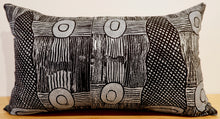Janet Marawarr 'Fishtrap and Billabong' Cushion - Black, 30x50cm
IDAIA x Babbarra
Regular price
€59.00
Sale
Art cushion cover 30 x 50 cm.
Fabric: Linocut on cotton fabric, hand-printed with eco-friendly inks by the women artists of the Bàbbarra Women's Center in the Aboriginal community of Maningrida in Arnhem Land .
Plain natural linen fabric on the back.
Removable with zipper.
Hand sewn in a Parisian workshop.
Machine wash cold possible.
Meaning of the fabric design:
The Kuninjku people traditionally make two kinds of conical fish traps: The mandjabu, larger and more resistant, is made from a strong and durable vine called mil, and the manylik mandjabu, lighter, is made from an herb called manylik.
The mandjabu trap is used in stream currents to catch large fish while the manylik is used to catch small fish and shrimp in freshwater streams.
In the past, only men were involved in making the traps, while children often crawled inside and helped with the work. To make the mandjabu, the weavers first harvest the millet (burney vine, Malaysia scandens) then soak it overnight in water to make it soft. They weave it to make rings inside to keep the shape of the fish trap. They also make twine from burdaga bark (kurrajong) to tie the bardainy (hibiscus) rings and the conical end of the trap. The work is delicate and it sometimes takes three or four weeks to build a trap.
Aborigines can also use other fish traps (kunkarlewabe) in the middle of which they place the mandjabu. They are also developing dams made of small sticks, rocks, mud and grass to keep the fish out.
They catch a wide variety of fish such as rajarra barramundi, freshwater barramundi (“ngaldadmurrng”), freshwater black catfish (buliya), bonefish (“an-guwirrpiya”) or even bars (“dalakan”).
Learn more about the collection
Complete with matching cushion insert
***
Cushion 'Fishtrap and Billabong / Nasse à Poissons et Billabong' by Janet Marawarr
Art cushion cover 30 x 50 cm.
Fabric: Linocut on black cotton fabric, hand-printed with ecological inks by the women artists of the Bàbbarra Women's Center in the Aboriginal community of Maningrida in Arnhem Land.
Backed with natural linen fabric.
Removable cover with zipper .
Hand sewn in a Parisian workshop.
Cold machine wash possible.
Explanations for the fabric design:
Kuninjku people traditionally make two sorts of conical fish traps. One is called mandjabu and is made from a strong, durable vine called mil, and a smaller one is called manylik mandjabu, and made from the grass manylik.
The mandjabu conical fish trap is bigger and stronger and used in tidal reaches of creeks to catch large fish. The smaller, lighter manylik trap is used in freshwater flowing creeks to catch smaller fish and freshwater prawns.
In earlier times, only men were involved in the construction of the large fish traps, but children would often crawl inside and assist. To make mandjabu, weavers firstly harvest mil (burney vine, Malaysia scandens) and put it in water overnight to make it soft. Then they start weaving it; they make rings for the inside to keep the fish trap's shape. People also make string from the bark of burdaga (kurrajong) to attach the bardainy (hibiscus) rings and to tie the conical end of the fish trap. It's hard work and it can take three or four weeks to make a fish trap.
People also use fish-net fences called kunkarlewabe. They would put the kunkarlewabe across rivers and creeks. In the middle they would place the mandjabu. They also used small things like sticks, rocks, mud and grass to block the fish from going through.
This way we would catch fish such as saltwater barramundi rajarra, ngaldadmurrng (freshwater barramundi), small black freshwater catfish (buliya), bonefish (an-guwirrpiya), and sand bass (dalakan) in the mandjabu.






